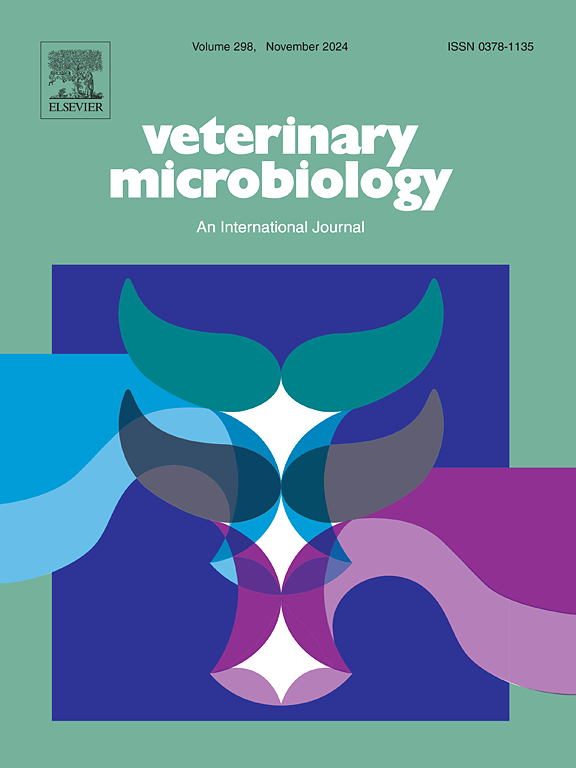Single-B-cell cloning and recombinant antibodies generation to analyze the antigenicity of porcine reproductive and respiratory syndrome virus nonstructural protein 12
IF 2.4
2区 农林科学
Q3 MICROBIOLOGY
引用次数: 0
Abstract
The prevalence and variation of porcine reproductive and respiratory syndrome virus (PRRSV) in China are increasing. The rapid preparation of essential antibodies will effectively reveal the antigenicity, epitopes, and intracellular distribution of viral proteins. Single-B-cell antibody technology is a novel method for screening diverse functional monoclonal antibodies (mAbs). Herein, we successfully expressed PRRSV nonstructural protein 12 (Nsp12) in suspension-cultured Chinese hamster ovary (CHO) cells. Using single-B-cell antibody technology, we utilized fluorescence-activated cell sorting to collect individual immune B cells and prepared single-cell reverse transcription-polymerase chain reaction to clone the variable region of immunoglobulin heavy chain (IgH) and immunoglobulin light chain (IgK). Two recombinant mAbs were generated via transient transfection of CHO cells with the corresponding expression plasmids of IgH and IgK. A novel linear epitope (104YEFTGNGEDW113) of Nsp12 was identified using mAb1N14. This epitope was conserved in lineages 1, 5, and 8 of PRRSV-2 and was located on the surface of the Nsp12 spatial structure. The amino acid mutation in Nsp12 of lineage 3 PRRSV-2 affected the antigenicity of this linear epitope. A conserved conformational epitope was identified using mAb2S18, and the spatial structure of Nsp12 showed high similarity between PRRSV-1 and different lineages of PRRSV-2. During PRRSV infection, Nsp12 was distributed in the cytoplasm and accumulated in the nucleus. Overall, antigenicity analysis and novel epitope identification contributed to the in-depth exploration of the biological function of Nsp12 and will facilitate the development of detection assays and antiviral strategies.
猪繁殖与呼吸综合征病毒非结构蛋白12的单b细胞克隆及重组抗体的产生
猪繁殖与呼吸综合征病毒(PRRSV)在中国的流行和变异呈上升趋势。必要抗体的快速制备将有效地揭示病毒蛋白的抗原性、表位和细胞内分布。单b细胞抗体技术是一种筛选多种功能单克隆抗体的新方法。我们成功地在悬浮培养的中国仓鼠卵巢(CHO)细胞中表达了PRRSV非结构蛋白12 (Nsp12)。采用单B细胞抗体技术,利用荧光活化细胞分选收集个体免疫B细胞,制备单细胞逆转录聚合酶链反应克隆免疫球蛋白重链(IgH)和免疫球蛋白轻链(IgK)可变区。用相应的表达质粒IgH和IgK瞬时转染CHO细胞,生成两种重组单克隆抗体。利用mAb1N14鉴定了Nsp12的一个新的线性表位(104YEFTGNGEDW113)。该表位在PRRSV-2的谱系1、5和8中保守,位于Nsp12空间结构的表面。3系PRRSV-2的Nsp12氨基酸突变影响了该线性表位的抗原性。利用mAb2S18鉴定出一个保守的构象表位,Nsp12的空间结构在PRRSV-1和PRRSV-2的不同谱系之间显示出高度的相似性。在PRRSV感染过程中,Nsp12分布于细胞质中,并在细胞核中积累。总的来说,抗原性分析和新的表位鉴定有助于深入探索Nsp12的生物学功能,并将促进检测方法和抗病毒策略的发展。
本文章由计算机程序翻译,如有差异,请以英文原文为准。
求助全文
约1分钟内获得全文
求助全文
来源期刊

Veterinary microbiology
农林科学-兽医学
CiteScore
5.90
自引率
6.10%
发文量
221
审稿时长
52 days
期刊介绍:
Veterinary Microbiology is concerned with microbial (bacterial, fungal, viral) diseases of domesticated vertebrate animals (livestock, companion animals, fur-bearing animals, game, poultry, fish) that supply food, other useful products or companionship. In addition, Microbial diseases of wild animals living in captivity, or as members of the feral fauna will also be considered if the infections are of interest because of their interrelation with humans (zoonoses) and/or domestic animals. Studies of antimicrobial resistance are also included, provided that the results represent a substantial advance in knowledge. Authors are strongly encouraged to read - prior to submission - the Editorials (''Scope or cope'' and ''Scope or cope II'') published previously in the journal. The Editors reserve the right to suggest submission to another journal for those papers which they feel would be more appropriate for consideration by that journal.
Original research papers of high quality and novelty on aspects of control, host response, molecular biology, pathogenesis, prevention, and treatment of microbial diseases of animals are published. Papers dealing primarily with immunology, epidemiology, molecular biology and antiviral or microbial agents will only be considered if they demonstrate a clear impact on a disease. Papers focusing solely on diagnostic techniques (such as another PCR protocol or ELISA) will not be published - focus should be on a microorganism and not on a particular technique. Papers only reporting microbial sequences, transcriptomics data, or proteomics data will not be considered unless the results represent a substantial advance in knowledge.
Drug trial papers will be considered if they have general application or significance. Papers on the identification of microorganisms will also be considered, but detailed taxonomic studies do not fall within the scope of the journal. Case reports will not be published, unless they have general application or contain novel aspects. Papers of geographically limited interest, which repeat what had been established elsewhere will not be considered. The readership of the journal is global.
 求助内容:
求助内容: 应助结果提醒方式:
应助结果提醒方式:


